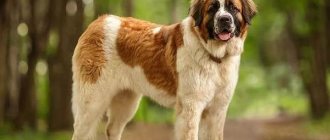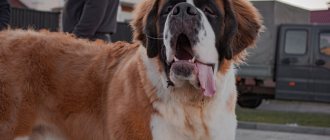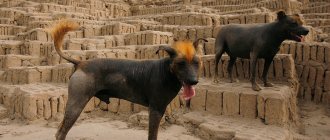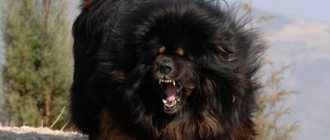There are quite a lot of monuments to dogs in the world; people love these four-legged pets during their lifetime and do not forget them after death. Perhaps the most famous monument to this animal is in Paris: the monument was opened almost two hundred years ago in honor of the famous dog, St. Bernard Barry. On the pedestal you can see a mighty dog and a child clinging to him in search of salvation.
Saint Bernards are the first dogs that were bred to perform rescue functions. They have been saving people for centuries, so the Barry monument is essentially a sign of gratitude to all animals of this breed.
Despite the development of technology, dogs are still indispensable assistants to rescue services today.
From the history of rescue dogs
In the Alps there is the Great Saint Bernard Pass. It is famous for its harsh weather conditions: in winter frosts reach -30 ° C, and bad weather rages here most of the year. Since the border between Switzerland and Italy passes right there, in ancient times there were brave souls who risked going through the pass using the shortest route. But many lost their way, fell into snowstorms and often died in an avalanche.
In the 11th century, the Saint Bernard Shelter was built on the pass. Here travelers could rest, refresh themselves and warm up before continuing on their way. But not everyone was able to reach this saving island.
The monastery of Saint Bernard still stands in its place, only having changed in appearance
In the 17th century, monks began to actively use dogs of the Alpine Mastiff breed to detect freezing, in trouble or lost travelers (after the name of the pass they later became known as St. Bernards). They were distinguished by their ability to anticipate bad weather and had an excellent sense of smell, thanks to which they could detect a person even under a snow pile. The dog’s task was to search for the victim, dig him out from under the snow and warm his face with his warm breath and tongue. These dogs did not have any kegs, much less alcohol.
Alcohol will not help a freezing person, but will only harm. Under its influence, blood vessels dilate and heat transfer increases, which, on the contrary, will accelerate freezing and hasten death for a person in trouble and immobilized.
Saint Bernards are still trained to search and rescue people in the mountains to this day.
Video: St. Bernard - a rescue breed
How to buy a Saint Bernard puppy
Buying a purebred puppy can be difficult, since the Saint Bernard is not a very common dog in our country. Moreover, in the 20th century the Moscow variety of the breed was bred. But there are many nurseries that can offer purebred St. Bernard. The price of such a puppy is 25-35 thousand rubles. For a show class dog you will have to pay more - from 50 thousand.
When choosing, you need to pay attention not only to the availability of all documents. It is important in what conditions the animals are kept, how the mother and puppies behave. The selected baby must be carefully examined. A healthy puppy has no watery eyes, clean ears, smooth and shiny fur, and a soft tummy. There should be no unpleasant odor from him, active and playful behavior.
The pictures show what the puppies look like:
More interesting photos of St. Bernards:
Before getting a St. Bernard dog, you should watch another video about it:
Video: Features of raising a St. Bernard dog
Video: The Saint Bernard is a smart companion, a great friend and a fearless guardian.
Video: St. Bernard - everything about the breed.
Saint Bernard is a large, but good-natured and calm dog. He is capable of becoming a good friend and protector. This pet is ideal for large families with children. But this giant requires a lot of space in the house, at least 3 hours of walks and communication. If you can’t pay attention to your dog, it’s better not to get this breed.
The most famous rescuer is Barry the dog
The most famous rescuer was an Alpine mastiff named Barry. The monks testified that he went in search of victims on his own, without waiting for a command from people, but simply anticipating the approach of a snowstorm or an avalanche. If he could not cope with the rescue on his own, Barry would return and bark for the monks to go after him. He has saved 40 lives.
Barry's effigy is on display at the Bern Museum
On the monument to Barry, erected in Paris opposite the entrance to the dog cemetery, it is written that he saved 40 people, and the 41st killed him. Allegedly, an unconscious Swiss soldier mistook Barry for a wolf and stabbed him with a bayonet. But there is evidence that the aged Barry lived out his life quietly with a monk in Bern and died at the age of 14.
After Barry's death, his body was buried, but the skin was removed, and with its help a stuffed dog was made, located in a museum in Bern. In 1923, during the reconstruction of the stuffed animal, a barrel was hung around the dog's neck to popularize the myth of rescue dogs created by the famous painter Edwin Landseer.
Training and education
Saint Bernards are smart dogs, but their phlegmatic temperament can hinder them during the training process. All commands are carried out slowly, there is no need to rush him. Over time he will pick up the pace. This must be taken into account when training.
Teaching a St. Bernard puppy commands is a very important part of the training process. Through training, the principles of discipline and self-control are instilled in the animal. A well-mannered dog will become safety and pride for every owner. Also, a disciplined pet will help out in case of potential problems during walks; it will not scare passers-by, chew slippers, create a mess in the house in the absence of its owners, etc.
Why train a St. Bernard?
- Firstly, when the dog learns commands, it will become more disciplined. After all, the animal must clearly understand what is allowed and what is strictly prohibited. If a dog lives in a family with children, everyone should feel comfortable being around it.
- Secondly, the dog must understand its place near the person. Pets come from wolves, where there is always an alpha in the pack, so the owner must become the leader. It is necessary to form an obedient, but at the same time respectful attitude towards the person.
- Thirdly, a dog often performs some function: watchman, hunter, guide, companion. Therefore, the animal must be trained in special commands in order to be able to perform a particular role. In such cases, the dog should be trained by a professional dog handler. Quite often, a dog is adopted as a friend with whom you can have fun. The animal becomes strongly attached to the person, and a strong friendship bond arises.
A St. Bernard puppy has appeared in the family, then help him get used to it faster and survive stress. To do this, it is enough to feed him with your own hands, play with him, communicate and spend time. Such simple actions will help establish a trusting relationship. The more the owner pays attention and care, the more loyal the dog will grow.
Where did the myth of the keg come from?
The idea of a barrel on a St. Bernard's neck came to the mind of the English artist Edwin Landseer, who often depicted dogs in his paintings.
A breed of dog was named after Sir Landseer - the spotted variety of Newfoundland - which he especially loved to portray.
In the painting “Alpine Mastiffs Revive a Lost Traveler,” the barrel first appears before the eyes of the audience. It was added “for piquancy,” for greater artistic expressiveness.
A keg of alcohol appears for the first time in Landseer's painting around the rescue dog's neck.
In fact, St. Bernard rescuers are necessarily provided with special first aid packages for victims. A dog can be the first to reach a person under the rubble and provide him with... not a sip of alcohol at all, but food and water to maintain strength, a blanket for warmth, and a first aid kit.
A rescue St. Bernard's bag contains only what will help a person maintain strength until people arrive, but alcohol is not included in this list
A barrel of alcohol around a St. Bernard's neck is a myth. Rescue dogs never wore them at all. This attribute is used only for photo sessions, emphasizing the importance of the mission of these animals.
- Author: Natalya Mikhailyuk
Rate this article:
(17 votes, average: 4.1 out of 5)
Saint Bernards became popular largely thanks to the family comedy “Beethoven” of the 90s, which was liked by millions of people around the world. But the history of this breed in itself is interesting and original.
It all started with the fact that in 962 Bernard of Menton founded a monastery and shelter for travelers in the Swiss Alps at an altitude of about 2500 m. The place was not chosen by chance; there was a mountain path along which pilgrims often walked, heading from France to Italy. The path was considered difficult and dangerous, because the traveler could always get caught in an avalanche, a snowstorm, or be attacked by villainous robbers. Bernard's idea was that the wounded and cold traveler could warm up, rest and heal in his shelter.
In 1681, Bernard of Menton was canonized, and the monks of his monastery began to breed dogs that would help them save travelers in trouble. Over the course of many years, the monks managed to breed a mastiff that was able to easily endure harsh weather conditions, was quite strong, but at the same time very friendly and loyal. A keen sense of smell and hearing made it possible to find people, even in a snowstorm and under the snow. Initially, the breed began to be called “Barry”, this nickname was given to one of the mountain rescue dogs. Barry (from the German Bären, “bear”) saved the lives of 40 people in the snow. Later they began to use the name "Saint-Bernard", that is, Saint Bernard, it was mentioned unofficially in 1833, and in 1880 it became official. Over the years, these friends of man are credited with saving more than 2,000 lives.
Photo www.lapkins.ru
With the advent of helicopters in 1950, the help of St. Bernards in rescuing those who were freezing began to rapidly lose relevance. The number of monks in the monastery also began to decrease, until there were only 4 of them left. Keeping such dogs is very expensive and labor-intensive, so the remaining monks decided to put the last pets up for sale in 2004, reasoning that it would be better for everyone, since there was work for the furry rescuers no more in the mountains. Nevertheless, this step caused widespread public outcry. Various entrepreneurs, whose business relied on thousands of tourists who come every year to visit the monastery and look at the famous dogs, were very indignant. The issue was resolved quickly; a couple of Swiss philanthropists were found who donated about $4,000,000 to ensure that the St. Bernards remained in the monastery, and breeding and caring for them continued. For these purposes, a non-profit organization, the Barry Foundation, was established. For the winter, the dogs are sent to a kennel in the Swiss city of Martigny, and in the summer they return to the monastery to the monks. In honor of the dogs, a museum was opened in Martigny in 2006.
Photo www.dskkapital.ru
PS Interesting detail. Saint Bernards are often depicted with a small barrel hanging from their neck. This accessory first appeared in a painting by Edwin Landseer, when he was only 17 years old. It was believed that the barrel contained brandy, which the dog treated to the frozen traveler. The concept quickly gained a lot of popularity in the community, but the dogs did not actually carry any kegs of booze. And it would be strange if you then tried to drag this drunken man to the monastery, otherwise he might even get there on his own, just show him the way. Not to mention, alcohol contributes to dehydration. But on the other hand, when the helicopter is already on its way, why not cash in on 150 with your faithful furry friend?
Subscribe and like! :)
A store where you can find everything at the best prices!
In Russia, St. Bernards are affectionately called “Senechka.” And the homeland of these giants is the Great St. Bernard Pass, which is located in the Alps. Many people prefer this breed of large dogs, which are the best rescuers because they can overcome very difficult to reach places. They are also considered a person’s great friends, as they are always ready to help him.
Nowadays
Saint Bernards are still used today to search for people in the Alps, but this happens quite rarely.
In 2004, the Barry Foundation was founded, the main purpose of which is to raise funds for the St. Bernard nursery in the Swiss village of Martigny. Every year, about twenty puppies are born there, which go to the monastery every summer, delighting tourists with their presence. Martigny is one of the main centers of breeding work with this breed. Unfortunately, every year there are fewer and fewer St. Bernards.
Also in Switzerland, the “Association for the Protection of the St. Bernard Breed” has been created, which studies the history of this legendary breed and its popularization.
In 2009, a museum of this famous dog breed was opened in Martigny, and a stuffed Barry was brought from Bern to the opening ceremony.
Saint Bernards are still used today to search for people in the Alps, but this happens quite rarely. Helicopters are much more often used for such purposes.
After a tunnel was dug under the famous pass, traffic along it practically ceased, and the need for rescue dogs disappeared. But the Saint Bernards came down from their snow-capped mountains and settled all over the world. They may have changed in appearance, but they have not lost their loyalty, kindness and willingness to sacrifice.
Saint Bernard Pass
There was a narrow rocky path through the St. Bernard Pass. It connected Italy with Western Europe.
In bad weather, when there were snowstorms and drifts, such a road became especially dangerous. In this place there was a monastery, which became a mountain shelter for travelers. It was founded by Bishop Bernard of Menton. This happened back in 1049. Then the pass and the monastery were named after the Bishop of Saint Bernard - Saint Bernard.
Nutrition
Adults have a stable metabolism and an intensive digestion process. It is recommended to feed adult dogs that have completed the process of body formation three times a day, but the best option would be split meals in small portions.
Due to their enormous body size, the St. Bernard's body must receive a sufficient amount of calories, in particular protein, as well as minerals and vitamins. You should not over-feed dog food or table food, as this will have a detrimental effect on the functioning of the digestive system.
Particular attention should be paid to the nutrition of St. Bernard puppies. The diet must be balanced and fully provide the puppies with all the necessary nutrients.
The younger generation has a fast metabolism and needs to be fed 5-6 times a day in small portions so as not to stretch the stomach. For the first couple of months, dogs receive nutrients from their mother's milk, then the puppies should be gradually introduced to feeding.
Like many St. Bernard breeds, they love to chew on a stick.
To begin with, you should choose milk as bait, then gradually switch to liquid milk porridges. Vitamins necessary for the development of dogs can be added to puppy milk. If there are a lot of puppies and it is difficult for the mother to feed the cubs, it is necessary to increase the amount of food for the mother, and start feeding the puppies a little earlier.
During the puppy period, you need to carefully monitor the health of dogs, because a deficiency of essential nutrients increases the risk of acquiring diseases or uneven body development. Without experience in caring for puppies, it is recommended that you seek advice from a veterinarian or dog breeder.
Dogs at the monastery
In difficult weather conditions, many people died, unable to reach the monastery. Then the monks got four-legged helpers - St. Bernards. These dogs were used to search for and rescue lost travelers. The animals were strong and resilient. They were distinguished by their great love for people. We felt a person in a snowdrift at a depth of up to six meters.
The dogs could navigate the mountains well and quickly found their way home. Anticipating an imminent change in the weather, they began to fuss, get nervous and hurried to go to the mountains on their own in order to come to the aid of the person in time.
About three or four dogs took part in searching for people in trouble. When the dogs found the victim, two of them lay down next to him, warming up the person, licked his face and shook him as best they could. And the rest ran to people for help.
Dog lovers consider the pass to be the birthplace of St. Bernards. And here, in the currently operating monastery, there is a famous nursery for breeding this breed.
And in a local hotel you can see a painting of a dog very similar to a St. Bernard.
Maintenance and care
It is best to keep a St. Bernard in a spacious private house with a plot. Such a giant will feel cramped in a small city apartment. Long-haired representatives of the breed live without problems in an outdoor enclosure; individuals with short hair are best kept indoors in winter. You cannot put a St. Bernard on a chain.
Saint Bernards are quite slow. But an adult dog needs to walk 3-4 hours a day. In summer, it is better to reduce walks; it is advisable for the pet to be in the shade. Due to their thick undercoat, these dogs cannot tolerate heat.
Caring for a St. Bernard is simple; normal hygiene procedures are required: rubbing eyes, ears, brushing teeth and trimming nails. Only because of the peculiarities of the structure of the muzzle is it necessary to wash it after eating.
It is advisable to comb long-haired animals every other day, and daily during shedding. You will need a comb with long, sparse teeth. For short-haired dogs, it is enough to brush them once a week. To do this, you can use a stiff brush or rubber mitt. It is better to trim the hair between the fingers and in the ears.
It is not recommended to bathe these dogs often - 2-3 times a year is enough. It is advisable to do this after shedding to facilitate hair change. After walks, you need to wash your paws; your pet should be taught this procedure from an early age.
The pictures show how to keep a St. Bernard:
Health
The health of representatives of this breed is not very good. Even with proper maintenance, St. Bernards do not live longer than 11 years. These dogs are prone to obesity and allergic diseases. But most often they have joint pathologies. They have dysplasia and dislocations. Eye diseases can also develop due to drooping eyelids.
Nutrition
Saint Bernards are prone to obesity, so you need to choose your diet carefully. It is recommended that you consult your veterinarian about how much food this dog needs. The easiest way to determine the amount of dry food is about 1 kg per day. Any premium or super-premium food for large breeds will be suitable.
When feeding naturally, the bulk of the diet should be lean meat. His adult dog requires at least 500 g per day. The rest is cereals, vegetables, fermented milk products. You can give cottage cheese, eggs, offal, sea fish. Sweets, legumes, fatty and fried foods, marinades, confectionery and baked goods are prohibited. Additionally, it is recommended to give vitamins, calcium and collagen are especially important.
What did the dog look like?
In those distant times, the dogs described were significantly different in appearance from modern St. Bernards. They were more mobile and less massive.
The advantage of this dog is its thick skin. It perfectly protects from cold and snow. Very thick, this short coat did not get wet, did not become covered with icicles, and perfectly protected against hypothermia.
A dog's resistance to bad weather is actually limitless - it can stay in deep snow for a day, even in the most severe storm, without the slightest harm to health.
The animal has a very high reaction speed and an exceptionally keen sense of smell. This is what allows her to quickly find people under the snow.
Dogs of the Snowy Peaks
Saint Bernard simply adores children, owners, his own home and everyone who lives in it. But he cannot stand strangers and small dogs.
Against small dogs Everything is clear to outsiders, but it is unknown what exactly causes disgust, or rather contempt, for small dogs in the St. Bernard. Maybe he feels their worthlessness? Perhaps, once upon a time, some oversized, impudent and mischievous dog deeply offended a large, good-natured and honest St. Bernard? Unknown. One thing is clear: in order for this huge dog to coexist peacefully with the little shaggy, yapping misunderstanding, they both must begin their life together almost from the very first day of their birth. Then, you see, it will all work out without screaming and bloodshed. Jupiter and the Monastery About two thousand years ago, Roman legions crossed the Alps. On the only pass connecting Italy with modern Switzerland, at an altitude of 2500 meters above sea level, Caesar's soldiers erected a temple in honor of Jupiter. Then the Romans disappeared somewhere, the empire ceased to exist, and the Alpine temple, like most monuments of that era, turned into ruins. But in 1050, a monk named Bernard, a native of the French city of Menton, built a monastery on the site of a destroyed Roman temple. Later it received a name in honor of its founder - the monastery of St. Bernard. The monks, who settled on a snowy pass in order not to get bored during the endless winters, came up with a very useful and necessary occupation for themselves - to find travelers lost in the mountains and, if necessary, provide them with shelter and food. Actually, monasteries, or rather shelters for travelers. there were two: Grand Saint Bernard on the pass separating Italy and Switzerland (now the highest Christian church in Europe is located there), and Petit Saint Bernard on the pass separating Italy and France. Where did Saint Bernards come from? Invaluable assistance in this hard work was provided to the monks by huge and surprisingly flexible assistants, who for a long time were called large Swiss dogs, avalanche dogs, shepherd dogs, or even holy dogs. The modern name - St. Bernards, after the name of the monastery - was assigned to the Alpine rescue breed by the Swiss Kennel Club only in 1880. No one really knows where this breed came from. There is an assumption that the monks’ pets are descendants of Tibetan mastiffs that arrived on merchant ships to Rome from distant Asia. It is no longer possible to find out how and why exactly these dogs ended up in the monastery a thousand years later. Maybe the Romans brought them there. But, unfortunately, all ancient records about the activities of the monks and their shaggy assistants were destroyed by a fire that occurred in the monastery at the end of the 16th century. The earliest surviving document, dated 1703, indicates that the monastery's cook made a harness that could be harnessed to a dog and used to help in the kitchen. Records from 1787 say that “avalanche dogs successfully repelled an attack by robbers.” These documents indicate that at the beginning of the 15th century, Saint Bernards already lived in the monastery and were considered full members of it. Ideal rescuers But, undoubtedly, the main and invaluable quality of the Alpine Saint Bernards, for which they were, in fact, called avalanche dogs for a long time, was the ability to find people in the mountains covered with snow or lost in a blizzard. It seemed that nature itself had adapted these dogs for such dangerous and noble work. Well-developed paw pads allowed the monastery dogs to quickly move across the crust without falling belly-deep into snowdrifts. The thick but short coat did not get wet or become covered with icicles, but at the same time it perfectly protected against hypothermia. In conditions of snow-capped mountains, when the air temperature rises just above zero for only a couple of months a year, four-legged rescuers could scour the pass for days on end in search of lost travelers. At the same time, St. Bernards not only look for those covered in snow, but also, with some sixth sense, predict avalanches in advance and sense a person hundreds of meters away in the most pitch-black snowstorm. Another remarkable property of St. Bernards is their exceptionally sharp sense of smell compared to other breeds. Irish writer and traveler Oliver Goldsmith, who at one time visited the hospice monks, Fr. Dog legend The most famous of the shaggy inhabitants of the monastery was a dog named Barry, who was born in the monastery in 1800 and died, one might say, in the line of duty in the fourteenth year of his life. The winter of 1812 was especially cruel. When the next snowstorm died down, the monks, accompanied by several dogs, went out to the pass in search of victims, and there were enough of them then. The soldiers of Napoleonic army, defeated by Russian troops, sought to take refuge in sunny Italy. Barry, who had already saved exactly 40 travelers from certain death over the past years, quickly picked up the trail of another person “buried” in a snowdrift. The dog began to tear up the snow, and soon the body of the French warrior appeared on the surface. The soldier showed no signs of life, and the dog began to lick him with her tongue and warm him with her breath. And then a tragedy occurred: the deserter came to his senses, saw a huge dog in the immediate vicinity, got scared, took out a knife and stuck it in his savior.” Barry had enough strength to crawl to the monastery. A manufacturer from Bern, who was visiting the monks, took the unfortunate dog with him and took him to a veterinary hospital. For two years people treated the brave dog, but age and the wound inflicted took their toll. Barry died in 1814. Saint Bernard was buried in a Paris cemetery. A bronze monument was erected to him, depicting Barry himself, carrying on his back the boy whom he once pulled out from under a snowfall. There is an inscription on the monument: “The valiant Barry saved forty people from death during his life. During the rescue of the forty-first, he died.” Since then, in the monastery kennel, one of the dogs always receives the nickname Barry - in honor of the legendary dog. Why do you need a keg of brandy? Many believe that St. Bernard search dogs do not go to work until a barrel of brandy is hung around their necks, intended for freezing travelers. This is pure myth, generated by a painting by the English artist, Sir Edwin Aandseer. In 1831, Sir Landseer painted a painting called Alpine Mastiffs Restoring a Lost Traveler, in which one of the St. Bernards has a barrel of brandy hanging around his neck. Sir Landseer drew this barrel completely arbitrarily; he probably liked to drink himself. In fact, the shaggy rescuers could at most have had a first aid kit with completely non-alcoholic contents hanging around their necks. But the myth of the brandy barrel has become so firmly established among the people that now, when St. Bernards pose for tourists visiting the monastery, the dogs’ necks are decorated with the notorious container. Now on the pass, in addition to the monastery, the border, cafes and shops for tourists, there is a dog kennel. Saint Bernards are raised, trained, walked in the mountains, and from autumn to spring they are sent down to winter quarters. For better or worse, dogs have not saved anyone for the last 40 years. Now this mission is performed by helicopters. Konstantin Fedorov weekly “Secrets of the 20th Century” No. 3 2014 posted with permission from Press Courier Publishing House, copying is prohibited
You will also be interested in the following news
- Saint Bernard at an exhibition
- History of the Saint Bernard breed
- Saint Bernards are rescue dogs!
- Mountain monks. Saint Bernard, history
- Travelers and rescuers
Monument to Saint Bernard Barry in Paris
It was installed about 180 years ago in a Paris cemetery. A bronze statue of a huge dog and a child clinging to it. On the pedestal there is an inscription: “Barry, who saved forty people and was killed forty first.” This is a monument to all St. Bernards who save people.
Among the dogs of this breed there were their champions. One of the famous rescuers was a St. Bernard named Leo. He has 35 saved souls to his credit. But St. Bernard Barry became more famous. It was he who saved forty people, and he himself died at the hands of the forty-first. There is a legend about how this all happened.
Attitude towards children and pets
Patient and gentle, they carefully let children put up with a lot. Always supervise any interactions between dogs and small children. Teach your child never to approach any dog while it is sleeping or eating, or to try to take food from it. No dog should be left unattended with a child.
They get along well with other pets, especially if they were introduced to them as puppies. However, this giant dog breed may accidentally step on or push your small pet.
How Barry died
One day there was a strong storm. The dogs, as usual, went out to search for the injured people. Gradually they returned to the monastery. Everyone was very tired and exhausted. Only St. Bernard Barry continued to search for those in trouble. He wandered and wandered among the mountains. Obviously, the dog felt that there was a person lying somewhere under the snow.
The dog's instincts were right. He found a traveler covered in snow. The dog began to free him from captivity. He shook and licked the poor fellow's face. But the man, waking up, opened his eyes and saw a large dog's face. Frightened, he decided that there was a wolf in front of him. A man killed St. Bernard Barry with a pistol.
According to another legend, a dog was stabbed to death with a knife. This was done by the forty-first person he saved.
Since then, a dog named Barry has always lived in the monastery kennel. It is named after him.
Breed standard
Dogs of this breed differ in parameters; the weight and size of the St. Bernard is impressive. Adults have a massive neck and head, and a convex forehead. The height of an adult male at the withers varies from 70 to 90 cm, the height of females - from 60 to 80 cm. The average body weight is not less than 80 kilograms; regular dog training allows you to achieve a weight of a hundredweight without harm to the health of the St. Bernard.
The coat of this breed depends on the variety; there are individuals with long or short fur, red or white color. A single-color color in St. Bernards is rare and does not correspond to the breed standard; usually the color of the coat alternates or is scattered with spots and marks of white, red and red shades. On the head there is a kind of mask of dark wool in the area of the eyes; the ears and paws are often spotted.
The photo shows a short-haired St. Bernard
The legend of saving a child
Another legend says that St. Bernard Barry is a hero dog. According to her, the dog actually saved forty-one people. The forty-first person saved was a child. No one knew how he got to the pass and found himself completely alone in a dangerous situation.
When St. Bernard Barry sensed him, the child was alive but unconscious. The dog helped in time: he lay next to the boy for a long time, warming him with his body, and licked his face. When the child woke up, he had no strength at all. All he could do was wrap his small arms around the dog's neck.
Barry tried to carry the baby very carefully. The dog was old and had a very hard time. The kid saw this and tried to ride the dog. This is how they came to people.
Barry lived out his life in the city and died of his own death, having served the people for about twelve years.
The story of St. Bernard Barry is true, and there is much evidence of it. The stuffed dog still stands in the Natural History Museum in the Swiss city of Bern.
St. Bernard's character
The Saint Bernard dog is very smart, obedient and calm. Its purpose is to help people. She is good-natured and completely devoid of aggression. He is kind even to strangers. But in a dangerous situation it will always protect its owner. Although next to such a giant no one would dare to harm him.
This pet is so attached to the owner and members of his family that he is ready to constantly be nearby and take part in all matters. But this dog will not impose himself. An adult St. Bernard has a calm, even melancholic temperament and shows almost no outward emotion. He loves to lie down and walks on the street with dignity and sedateness.
Innate rescue instincts make this dog a good nanny. He loves children, is always patient and gentle with them, and protects them. A striking example of this behavior is the St. Bernard Beethoven from the film of the same name. It is also peaceful towards other animals.
Interesting pictures characterize the behavior of these dogs:
Features of education and training
The Saint Bernard is easy to train, especially at an early age. He tries to please the owner, understands the words. But he doesn’t always follow commands right away. Sometimes this is due to stubbornness, but mostly due to temperamental characteristics, since St. Bernards tend to fall into thoughtfulness.
It is necessary to socialize the puppy on time. From the first days of his arrival in the house, you need to teach him:
- do not chew or throw things around;
- respond adequately to street noise and cars;
- patiently withstand hygiene procedures;
- walk on a leash and muzzle.
Puppies are smart, they need to start training no later than 2 months. Their peculiarity is that St. Bernards grow up quickly and after 2 years are no longer able to learn new things. An ill-mannered dog of this size can cause problems. After all, even in the absence of aggression, he overwhelms with his weight and size, he can knock a person down, and if he runs, it will be impossible to hold him.
This dog understands basic commands quickly and easily masters various skills. You just need to take into account that jumping and intense physical activity are contraindicated for St. Bernard puppies. They can lead to joint diseases.
During training, you need to interest your pet. Reward correct behavior with treats and praise. Hitting or rudely scolding a St. Bernard is unacceptable. He may lose interest in activities.
This video will help you learn how to raise St. Bernards:
Video: St. Bernard puppy OKD, the work of an instructor teaching the owner how to train a dog
Video: How to properly train a St. Bernard!
Video: Saint Bernard features of training and education
Characteristics of a rescue dog
The breed of the pet must correspond to the goals and conditions of the search and rescue operation. For example, dogs that are able to withstand low temperatures and have sufficient physical strength to not only indicate the location of a person, but also dig him out and pull him out from under the snow, are most effective in helping to rescue climbers.
However, good physical data is not all that is required from a four-legged rescuer. If he is psychologically unable to work in extreme conditions, then his use in rescue operations is inappropriate.
During the training process, the dog is taught many important skills that help perform the surgery effectively. During training, her psychological and physical capabilities are also assessed. According to experts, a rescue dog must have the following qualities:
- excellent physical shape, strong physique;
- well-developed sense organs: vision, smell, hearing;
- endurance;
- equilibrium;
- courage;
- stress resistance;
- good learning ability;
- high intellectual abilities: the ability to quickly and accurately respond to human commands, as well as act independently (in emergency cases);
- the ability to communicate with strangers and other animals and to react calmly to them.
To become a rescuer, an animal undergoes serious training. Based on the results of the training, specialists decide on the possibility of his participation in search operations.
A true security guard and family man
The true purpose of St. Bernards, in addition to rescue activities, is to be a watchman and security guard.
In most cases, these dogs do not have to use “serious arguments”, because their impressive appearance alone is enough to change the plans of an ill-wisher.
In the event of a direct threat, such a dog will protect its owner until the last breath.
St. Bernards treat other (even aggressive) dogs, as they say, “in parallel” if there is no direct threat.
Photo 7. Saint Bernards are great family friends
Saint Bernards need to feel that they are needed. These are dogs that get along well in the bustle of the city, in an apartment, subject to regular and obligatory walks.
Despite the fact that Saint Bernards are leisurely by nature, they can be very active when it is necessary to take part in some event, playing with children or on an active walk.
Saint Bernards love it when they are given some responsibilities - to look after something (or someone), to carry something.
They enjoy being directly involved in the life of their owner's family, where he will be the most loving pet in the world.
An important character trait of St. Bernards is their desire to be in company. They tolerate loneliness very poorly, lose their vigor and can even “catch” depression if they have been alone for a long time.
Many owners of such pets note that even if you leave the St. Bernard at home with the most ordinary cat, then, believe me, these two will definitely not be bored. The main thing is that he is not completely alone for a long time.
From their rescue ancestors, St. Bernards inherited not only the best physical and mental characteristics, but also the ability to navigate and find their way back even from the most dense places.
Your dog will always lead you out of the forest and show you the way back home.
During their walks, St. Bernards usually keep you (or the house) in sight so that they can quickly return when called.
Saint Bernards practically do not bark in normal circumstances (unlike, for example, the Pyrenean mountain dog); they only give voice when it is truly necessary.
For example, to warn an ill-wisher that he does not belong here, or to notify the owner that someone knocked on the door.
Mountain rescuers
Mountains are considered one of the most difficult places to work. Low temperatures, strong winds, as well as sudden changes in weather conditions require unprecedented endurance from animals and humans. To work in the mountains, strong, large animals are used to be able to get a person out of the rubble or bring equipment. Their coat should be thick, with a dense undercoat, which protects them from low temperatures.
Saint Bernard
These dogs have been rescuing climbers in the mountains for several centuries. Initially, they were used for protection by the servants of the monastery of St. Bernard in the Swiss Alps (XVII century), hence the name of the breed (Saint-Bernard).
Over time, climatic conditions in the Alps began to change and cases of snow melting became more frequent. Saint Bernards began to be used not only as guards, but also as escorts when crossing the mountains. They have a flexible disposition and endurance, so they were often used as pack animals for transporting goods. Their ability to predict avalanches often saved the lives of travelers.
Saint Bernards are very affectionate, calm and friendly. They treat small children with care and patience, are not afraid of strangers and react calmly to other animals. They are not aggressive and will not bark without a reason. However, if threatened, their instincts will react quickly.
Saint Bernards are intelligent and trainable. They have an excellent sense of smell, capable of sensing a person at great depths under the snow. They are able to dig out the victim and signal his location to the rest of the rescue team.
Dogs of this breed are large and powerful. Their average height is 80 cm, and their weight is more than 70 kg. They have thick, long or short (depending on the breed type) coat with undercoat. This coat allows them to withstand cold temperatures and can help warm injured climbers.
German Shepherd
The German Shepherd is one of the most popular working dogs. It is used in various spheres of human life (security, police, military service, etc.). These dogs also help climbers and other victims of various disasters.
German Shepherds are versatile. They cope well with search operations, both in the mountains (in cases of snowfalls) and in the lowlands after earthquakes and other disasters, looking for people under the rubble.
German Shepherds are suitable in all respects for working in special operations in the mountains:
- they are smart and easy to train;
- balanced, psychologically stable;
- quickly adapt to unfamiliar surroundings and navigate the terrain;
- withstand cold weather;
- have good health.
The average height of a shepherd dog is 50-60 cm, and weight is 50 kg. She has an excellent sense of smell, vision and hearing, which allows her to find the victim at great depths. At the same time, trained shepherd dogs are able not to be distracted by extraneous smells and noises, concentrating on searching work.
German Shepherds have a powerful muscular corset and strong paws. This helps them dig a person out of the rubble. And well-developed sense organs make it possible to guide the victim to a safe place (shepherd dogs are also often used as guides for blind people).
Bernese Mountain Dog
The breed was originally bred in Switzerland. The Mountain Dog's tasks included herding livestock, performing guard functions and being a faithful companion for humans. This breed perfectly performs these tasks to this day.
The Bernese Mountain Dog is a large and strong dog. Her average height is 60-70 cm, and her weight is about 50 kg. She has long and thick hair, which allows her to withstand frost well.
The breed is distinguished by a high degree of socialization, friendly disposition, calm character and obedience. Therefore, pets are often used to search for people during disasters. They know how to clearly follow commands and interact with a stranger. They can quickly track down a victim in the rubble, attracting the attention of the search party to the desired location with loud barks.
Alaskan Malamute
These are energetic and strong dogs, characterized by strength and endurance, independence and intelligence. Their average height is 60 cm, and their weight is no more than 40 kg. Outwardly, they look like a wolf, but they are absolutely domestic pets with a delicate mental organization that cannot tolerate loneliness. Initially, the breed was created to help people living in northern latitudes:
- for transporting goods over long distances;
- for hunting seals, polar bears, etc.;
- for protection from wild animals and intruders.
Nowadays, the Alaskan Malamute is often used for search and rescue operations. It has important characteristics that are necessary for working in extreme conditions:
- endurance, the ability to work long hours;
- strength (dogs are able to easily transport heavy loads in a sled, including a wounded victim);
- an innate love of digging deep holes;
- intelligence (Alaskan Malamute can make decisions independently, without human command).
A stubborn disposition and excessive independence often cause difficulties in raising a pet. Therefore, his training is carried out by experienced specialists. With proper training, the Alaskan Malamute will become an excellent rescue dog and reliable companion.
The kind and smart descendant of Barry
Along with their attentiveness and tenderness, Saint Bernards are characterized by a high level of intelligence.
Photo 6. Kind and smart descendant of Barry
This is due to the rescue activities that their ancestors have been engaged in for a very long time.
Such a pet can easily take on independent decision-making and searching for ways out of the current situation.
These dogs are very good with children, who, in turn, are simply happy to play with such a large pet.
The loyal attitude of St. Bernards also extends to other household inhabitants - they easily get along with cats or other dog breeds.
Making a diet for your pet
The diet of representatives of this breed should also be taken seriously. You cannot overfeed your dog or break the regime. In this case, it would not hurt to consult a veterinarian to select a diet.
During the week, St. Bernard needs to eat:
- boiled and raw beef, lamb or horse meat;
- processed heart, liver, lungs;
- buckwheat, rice or oatmeal porridge;
- vegetables;
- seafood;
- fermented milk products;
- chicken eggs;
- fish without bones;
- bread;
- pasta.
Find out if you can give your dog dry food.
Selection and cost of a puppy
The St. Bernard breed has regained popularity with the appearance of the film “Beethoven” , which fully illustrates all the behavioral features and character of these dogs.
Buy a puppy only from a trusted breeder. The main requirement is that the baby must look strong and active. A healthy dog's eyes should be clean and its nose should be wet.
The price of a St. Bernard without a class is about $200 . A pet-class pet costs approximately $200-300. A higher class, brid, can be purchased for $300-600. The most expensive puppies are those of the show class. Their price exceeds the $700 mark.
Important! When choosing a puppy, pay attention to its parents.











